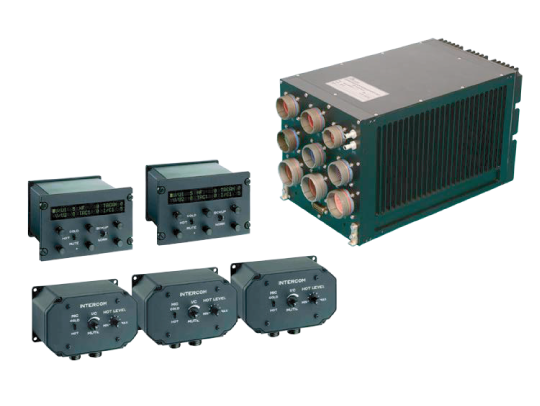SP-1450/N-E
Airborne Intercommunications System
The SP-1450/N-E Intercommunications System (ICS) completes the company’s line of defense communications products for applications onboard fixed-wing and rotary-wing aircraft. It has been designed to manage all radio communications and navigation equipment, data links, and internal/external communications facilities and to integrate their functionality into a single, Tempest-proven, architecture.
The SP-1450/N-E ICS provides switching and routing functions to configure the platform’s internal and external communications resources and relevant access by the users to such facilities. These functions are supported by control, amplification, and interfacing for all the radio communications facilities installed on the platform and by flexible intercom facilities.
The digital design of the SP-1450/N-E ICS is modular, flexible, and based on an open architecture so that it can be configured to meet various requirements. Extensive use of fiber optics connections and appropriate wiring layouts are used to reduce crosstalk and EMI in order to satisfy all TEMPEST requirements.
The SP-1450/N-E ICS is configured into the following LRUs:
- Communications Management Unit (CMU) SP-1451/N-E
- Main Station Unit (MSU) SP-1452/N-E
- Secondary Station Unit (SSU) SP-1453/N-E

- Key Features
- Key Benefits
- Product Datasheet
- TEMPEST performance compliant with AMSG 784B Volume I requirements
- EMI performance compliant with MIL-STD-461 specifications
- MIL-E-5400 requirements
- Extended components/functions integration, to allow for weight and volume saving
- Full system redundancy for critical functions
- Analogue Back-up circuitry for three Main Users
- Interface with different cryptos and LINK-11 DTS
- Integrated Warning Tones Generation and management function Integrated Headset Interfaces (hi/lo impedance and/or stereo headset compatible)
- Sunlight readable and NVG compatible operator panels
- Hot-mic mode in intercom operation
- Software oriented design for maximum flexibility and growth capability
- Digital switching matrix for voice/data routing and distribution
- Selection by the user of the desired communications channel(s)
- Remote control of the system’s configuration by the aircraft computer over multi-bus interface (MILSTD-1553)
- BITE capability with identification of the failure at LRU level
- Modular construction
- Use of fiber optics signal bus to avoid crosstalk
CMU
The Communications Management Unit, including the WTG/DVO (=Warning Tone Generator/Direct Voice Output Unit - is a digital switching matrix which, under control by the MIL-STD-1553 Bus (or ARINC 429) of the aircraft, configures the communications resources by implementing the following functions:
- Control of the operating parameters of the radios, cryptos and modems
- Routing of crypto and modems through external communications equipment HF to V/UHF and V/UHF to HF relay, i.e. Retransmission over the V/UHF channel of information received over the HF channel and vice versa
- Public Address function by using of external audio amplifier
- Management and routing of Navigation Aids, alarms and alert signals
- External interfaces number growth up capability by embedded board population.
MSU
Each Main Station Unit allows the Main crew members (pilots and mission operators) to control the assigned on board audio sources (Radio transceivers, NAVAIDS/SONAR/ ESM, etc.) and to interface their own headset with the desired audio channels.
SSU
The Secondary Station Unit allows the Secondary crew members (gunner, loading ramp operator, ground service personnel) to be a user of the assigned audio set, so to
receive external communications channels or to access the intercom facilities. Different System configurations are available for aircraft of different types, all using common units and modules. System designed in cooperation with Becker for MSU and SSU.

